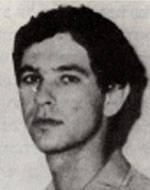Amos, son of Leah and Simha, was born on 7/11/1946 in Afula, the son of parents who were both veterans of the British army, and Amos lived in Tel Adash at the age of five and moved to Afula, “He was also an excellent basketball player and eventually went on to a basketball court, and was a instructor in the Gadna-Air courses and a member of a civilian club for Daya. By nature he was a friendly and active boy. He traveled extensively around the country and looked for new landscapes, and especially loved unique trees and stones. Amos enlisted in the IDF in early 1964 and volunteered for the Paratroopers Brigade, where he was transferred to the Armored Corps, where he completed an officers ‘course and a platoon commanders’ course in the Armored Corps. As a company commander he also participated in raids on Syria and Lebanon, where Amos used to delve deeply into every subject he was involved in. , Where his eldest son was born, after his discharge from service He studied with his family in Nahalal and studied at the University of Haifa for two years in the geography and sociology departments at the University of Haifa, where he became a member of Egged and began working as a driver Amos was a prominent family man, who devoted his free time to work with his wife and children, To establish a residential neighborhood for young people in the mountains above Nahalal, and he began to deal with the implementation of the plan, held meetings and meetings with colleagues, and already spoke to the Israel Lands Administration about this issue. In the Yom Kippur War, Amos commanded his unit on the Golan Heights. Already on the first day of the war, Karev led a force of three tanks, during which a reconnaissance unit was rescued from an ambush by the Syrians. After that, he took part in several armored battles against the Syrians and succeeded in clearing one of the main arteries of the Golan Heights, where Syrian tanks tried to reach the Nafah camp and the Bnot Yaakov bridge. When his unit was deployed beyond the “Green Line” into Syrian territory, Amos was already packed with a battalion commander and took the place of his predecessor, who was wounded before the attack began, and he spoke with the crew members and encouraged them to prepare for the battle. On October 11, 1973, Amos crossed the “Green Line” and headed east on the “America” axis, directing his soldiers’ action on the radio, encouraging them to continue moving forward quickly. He was brought to rest in the cemetery in Nahalal, leaving behind a wife, a son and a daughter, who was promoted to the rank of major. “On October 7, 1973, the commander of the battalion, Amos BenDavid, left with the first force of the battalion and fought. With a few tanks, in a brazen spirit, against better enemy forces, and destroyed them by exploiting the ground conditions and the element of surprise. This stopped the flow of the Syrian enemy on the Kuneitra road – the Benot Ya’aqov bridge. At the end of the day he remained alone with his tank. He joined the brigade car park, and by night he had entered braking posts until the morning light. The next day, Monday, October 8, 1973, he drove off the Syrian enemy, who managed to break into the direction of ‘Nafah’ and pursued him, even though his armament had run out. On Tuesday, October 9, 1973, a force of tanks headed through enemy lines and rescued a reconnaissance force attacked by a Syrian commando force. The next day, Wednesday, October 10, 1973, he fought in the wings of many Syrian tanks and destroyed a large part of them south of Tel Yosef. And on Thursday, before the break-in, he spoke with his fighters and raised their morale and in the breakthrough itself he was killed. Amos Son of-David z “l excelled with great courage, cold-heartedness, resourcefulness, and great peace of mind that he succeeded in passing on to his subordinates, thereby creating confidence and faith in them.”
